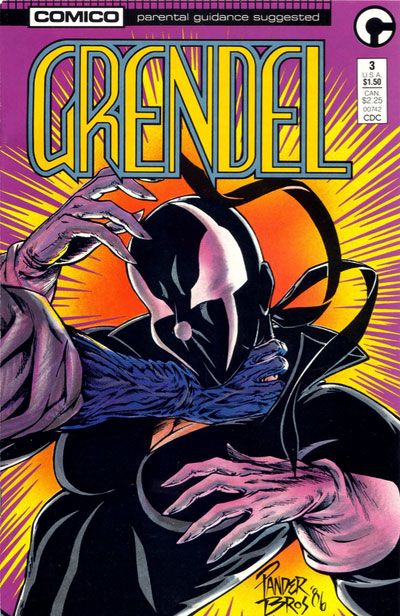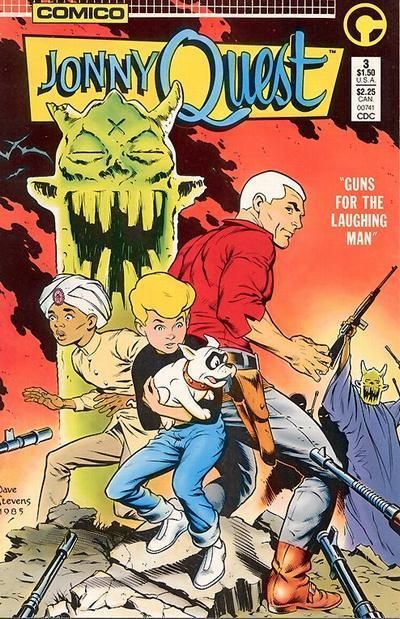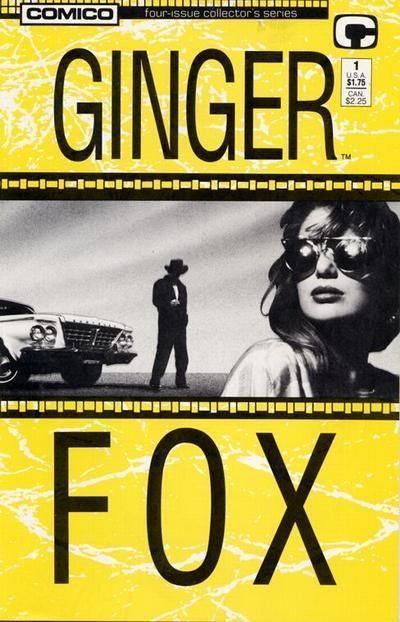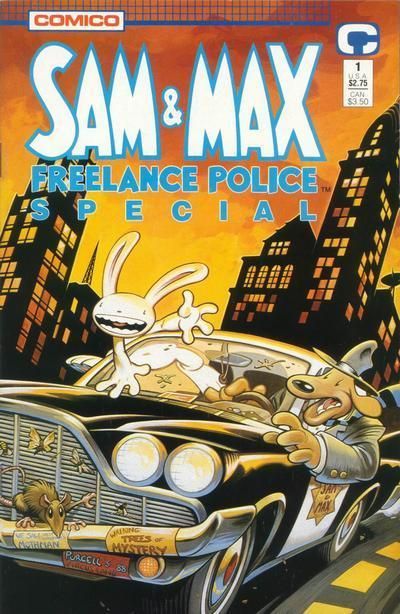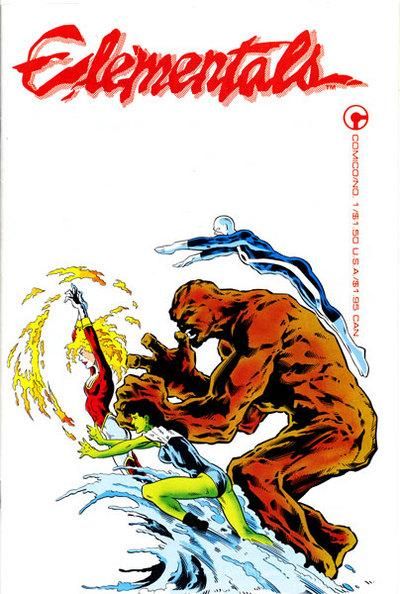The birth of the direct market brought a slew of new independent publishers in the 1980s, including First Comics, Eclipse and Comico. It was the latter that really made an impact on both myself and Strangeways creator Matt Maxwell at the time.
In an email discussion earlier this week about 1980s comics, the subject turned to Comico, and Matt and I started listing some of our favorite series by the publisher. So when I decided to make them the focus of this edition of Six by 6, I reached out to Matt to see if he'd be interested in helping me out this week. "I started expanding my horizons right about the time they started publishing comics," he told me, a sentiment I can echo. Elementals, in fact, may have been the first non-Marvel/DC comic I ever bought.
So without further ado, here are six great titles (actually seven, if you'll note how Matt slipped in an extra title in his last entry -- sneaky!) that Comico published back in the day.
1. Grendel, written by Matt Wagner, art by Matt Wagner and a host of others: I missed out on the Comico Primer and the very early Grendel material, but I came on board for Devil by the Deed, which was a graphic novel retelling of those stories that came out about the time that the Devil's Legacy (written by Matt Wagner with art by the Pander Brothers) started up. In short, I was blown away by the range of the themes at play in Wagner's storytelling (and by the hyper-stylized renderings of the Panders.) The first convention sketch I paid for was a Christine Spar Grendel (right before I got Stephen Bisette to draw Cthulhu). Grendel really was a comic for grownups when such a thing was a comparative rarity. I can't do it justice in the time I have here, but really, every fan of sequential storytelling owes it to themselves to catch up on this book, which I believe is being reprinted in its entirety by Dark Horse. Romance, treachery, betrayal, crime, noir, science fiction, dark fantasy, even straight superheroics can be found in the pages of Grendel, not to mention an incredible range of formal techniques and experimentation, and work by artists who are both superstars now and all but forgotten, sadly. (Matt Maxwell)
2. Jonny Quest, written by Doug Wildey and William Messner-Loebs, art by Marc Hempel, Mark Wheatley, Steve Rude, Doug Wildey, Wendy Pini, Joe Staton and many more: I remember as a kid that the reruns of the Jonny Quest cartoon from the 1960s came on really early, like maybe 6 a.m. early, so it was rare that I was actually awake enough to watch them. But I do remember seeing some of them and thinking how cool they were. In the 1980s, Hanna-Barbera brought the Quest family back, in the form of edited versions of the 1960s cartoons as well as new episodes. It was around that time, I think, that Comico started publishing its Jonny Quest comic. The series started with a bang, as Jonny Quest creator Doug Wildey wrote and drew a story for the first issue, with William Messner-Loebs taking over the reigns from there. Those first few issues featured artwork by a "who's who" of creators -- Tom Yeates, Steve Rude, Adam Kubert, and even covers by Dave Stevens. Eventually Marc Hempel and Mark Wheatley settled in as the art team for the book, which ran for 31 issues (not including a few specials done by Wildey). It was a fun series that stayed true to its cartoon action, adventure and intrigue roots. (JK Parkin)
3. Ginger Fox, written by Mike Baron and art by the Pander Brothers: I'll admit to skipping out on the World of Ginger Fox graphic novel, but the miniseries with art by the Pander Brothers was one of my absolute favorites of the 80s. Like JH Williams, the Panders made every script they drew a hundred times smarter and sharper, and what could have been a forgettable throwaway story set in the glitz of 80s Hollywood becomes a crazed and memorable fourth-wall-breaker. And nobody seems to remember this but me, however, the Pander Brothers had been tapped for a Max Headroom comic that never saw the light of day, but really should have, given the preview art that I'd seen. Scour the dollar bins for these. Can't miss the photo-covers. (Matt Maxwell)
4. Mage, written and drawn by Matt Wagner: I still remember seeing all the hype around this one. It was around the time I started reading and subscribing to stuff like Comics Buyer's Guide and Amazing Heroes and other comic-oriented magazines, and I started realizing there was a business and creators and such behind all these comics I loved. Mage was a fairly well-regarded and well-reviewed series by a lot of folks, both reviewers and comic fans alike, and just picking up an issue would tell you why. The Hero Discovered, the first of three planned books in the Mage story, introduced Kevin Matchstick, the reluctant hero who, it would turn out, was the reborn King Arthur. Armed with a magical baseball bat that filled in for Excalibur and guided by Mirth, his Merlin, Matchstick would go on to discover his destiny and fight the forces of evil in the form of the Umbra Sprite. This series and its sequel have both been collected by Image, and hopefully one day soon we'll get to see the final part of the trilogy. (JK Parkin)
5. Sam and Max: Freelance Police and Gumby Holiday Specials, written by Steve Purcell and Bob Burden, art by Purcell and Art Adams: This is cheating a little bit, since I got into Sam and Max by way of the Epic comics collection of some of the older material. But upon reading those, I made it my business to track down copies of all the Comico material, where it had originally appeared. If you don't know the wonder of Sam and Max, or worse yet, you can't enjoy them, then there's really no hope, is there? They're the stars of a funny animal book that is often only funny for the wrongest of reasons, where mayhem is always a heartbeat away, and where pain can come from the fuzziest of fists. One of the Gumby specials, with art by Art Adams if memory serves, was also written by Mr. Purcell, and both are light-heartedly deranged stories that should appeal to anyone who has a soul. Is that a wide enough net? I'd love to see the Gumby material get reprinted (and have heard rumors to that effect). The Sam and Max books have been reprinted by Mr. Purcell himself, I believe, and are usually available at shows, and maybe even through Diamond. (Matt Maxwell)
6. Elementals, written by Bill Willingham, with art by Willingham and others: I was fairly young when the first issue of Elementals came out, but I can still remember how the cover practically jumped off the shelf when I first saw it. I was a big fan of superheroes, of course, and had been devouring Marvel and DC's output for years, but here was something that really stood out amidst the patchwork of covers up on that wall at Lone Star Comics. The brightly colored heroes against the stark white background were eye-catching. Of course, it's what's inside that counts, and that first issue hooked me pretty early. This book had it all -- death, sex, violence, betrayal, vampires, religion, shady government types, larger-than-life supernatural destruction -- as well as several great characters the book was built around. In addition to four well-developed main characters -- Fathom, Monolith, Vortex and Morningstar --I always thought the villain, Lord Saker, was one of the cooler concepts in villainy at the time. His origins came from Biblical times, as he was raised from the dead by a false prophet, and the separation from God combined with his new-found immortality kind of drove him nuts. And very, very evil. Overall this was a heck of a book and a great introduction for me personally to a new world of comics. It's a shame it isn't still in print. (JK Parkin)


